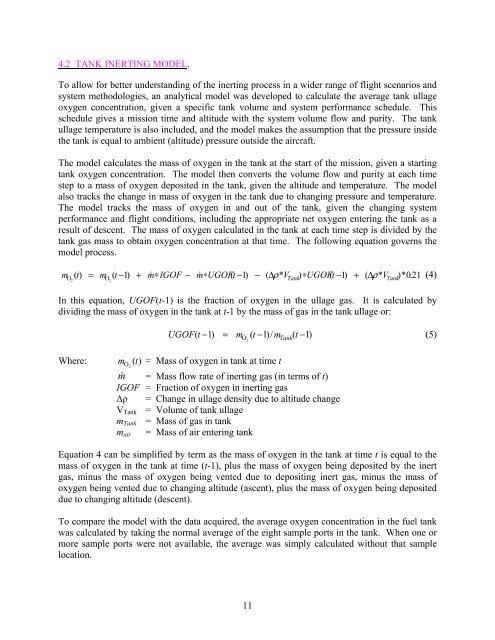Flight-Testing of the FAA Onboard Inert Gas Generation System on ...
Flight-Testing of the FAA Onboard Inert Gas Generation System on ...
Flight-Testing of the FAA Onboard Inert Gas Generation System on ...
Create successful ePaper yourself
Turn your PDF publications into a flip-book with our unique Google optimized e-Paper software.
4.2 TANK INERTING MODEL.<br />
To allow for better understanding <str<strong>on</strong>g>of</str<strong>on</strong>g> <str<strong>on</strong>g>the</str<strong>on</strong>g> inerting process in a wider range <str<strong>on</strong>g>of</str<strong>on</strong>g> flight scenarios and<br />
system methodologies, an analytical model was developed to calculate <str<strong>on</strong>g>the</str<strong>on</strong>g> average tank ullage<br />
oxygen c<strong>on</strong>centrati<strong>on</strong>, given a specific tank volume and system performance schedule. This<br />
schedule gives a missi<strong>on</strong> time and altitude with <str<strong>on</strong>g>the</str<strong>on</strong>g> system volume flow and purity. The tank<br />
ullage temperature is also included, and <str<strong>on</strong>g>the</str<strong>on</strong>g> model makes <str<strong>on</strong>g>the</str<strong>on</strong>g> assumpti<strong>on</strong> that <str<strong>on</strong>g>the</str<strong>on</strong>g> pressure inside<br />
<str<strong>on</strong>g>the</str<strong>on</strong>g> tank is equal to ambient (altitude) pressure outside <str<strong>on</strong>g>the</str<strong>on</strong>g> aircraft.<br />
The model calculates <str<strong>on</strong>g>the</str<strong>on</strong>g> mass <str<strong>on</strong>g>of</str<strong>on</strong>g> oxygen in <str<strong>on</strong>g>the</str<strong>on</strong>g> tank at <str<strong>on</strong>g>the</str<strong>on</strong>g> start <str<strong>on</strong>g>of</str<strong>on</strong>g> <str<strong>on</strong>g>the</str<strong>on</strong>g> missi<strong>on</strong>, given a starting<br />
tank oxygen c<strong>on</strong>centrati<strong>on</strong>. The model <str<strong>on</strong>g>the</str<strong>on</strong>g>n c<strong>on</strong>verts <str<strong>on</strong>g>the</str<strong>on</strong>g> volume flow and purity at each time<br />
step to a mass <str<strong>on</strong>g>of</str<strong>on</strong>g> oxygen deposited in <str<strong>on</strong>g>the</str<strong>on</strong>g> tank, given <str<strong>on</strong>g>the</str<strong>on</strong>g> altitude and temperature. The model<br />
also tracks <str<strong>on</strong>g>the</str<strong>on</strong>g> change in mass <str<strong>on</strong>g>of</str<strong>on</strong>g> oxygen in <str<strong>on</strong>g>the</str<strong>on</strong>g> tank due to changing pressure and temperature.<br />
The model tracks <str<strong>on</strong>g>the</str<strong>on</strong>g> mass <str<strong>on</strong>g>of</str<strong>on</strong>g> oxygen in and out <str<strong>on</strong>g>of</str<strong>on</strong>g> <str<strong>on</strong>g>the</str<strong>on</strong>g> tank, given <str<strong>on</strong>g>the</str<strong>on</strong>g> changing system<br />
performance and flight c<strong>on</strong>diti<strong>on</strong>s, including <str<strong>on</strong>g>the</str<strong>on</strong>g> appropriate net oxygen entering <str<strong>on</strong>g>the</str<strong>on</strong>g> tank as a<br />
result <str<strong>on</strong>g>of</str<strong>on</strong>g> descent. The mass <str<strong>on</strong>g>of</str<strong>on</strong>g> oxygen calculated in <str<strong>on</strong>g>the</str<strong>on</strong>g> tank at each time step is divided by <str<strong>on</strong>g>the</str<strong>on</strong>g><br />
tank gas mass to obtain oxygen c<strong>on</strong>centrati<strong>on</strong> at that time. The following equati<strong>on</strong> governs <str<strong>on</strong>g>the</str<strong>on</strong>g><br />
model process.<br />
m ( t) = m ( t −1)<br />
+ m&<br />
∗IGOF<br />
− m&<br />
∗UGOF(<br />
t −1)<br />
− ( ∆ρ<br />
* V ) ∗UGOF(<br />
t −1)<br />
+ ( ∆ρ<br />
* V ) * 0.<br />
21 (4)<br />
O O<br />
Tank<br />
Tank<br />
2<br />
2<br />
In this equati<strong>on</strong>, UGOF(t-1) is <str<strong>on</strong>g>the</str<strong>on</strong>g> fracti<strong>on</strong> <str<strong>on</strong>g>of</str<strong>on</strong>g> oxygen in <str<strong>on</strong>g>the</str<strong>on</strong>g> ullage gas. It is calculated by<br />
dividing <str<strong>on</strong>g>the</str<strong>on</strong>g> mass <str<strong>on</strong>g>of</str<strong>on</strong>g> oxygen in <str<strong>on</strong>g>the</str<strong>on</strong>g> tank at t-1 by <str<strong>on</strong>g>the</str<strong>on</strong>g> mass <str<strong>on</strong>g>of</str<strong>on</strong>g> gas in <str<strong>on</strong>g>the</str<strong>on</strong>g> tank ullage or:<br />
UGOF O<br />
Tank<br />
( t −1) = m ( t −1)<br />
/ m ( t −1)<br />
Where: O ( ) = Mass <str<strong>on</strong>g>of</str<strong>on</strong>g> oxygen in tank at time t<br />
2<br />
t m<br />
m & = Mass flow rate <str<strong>on</strong>g>of</str<strong>on</strong>g> inerting gas (in terms <str<strong>on</strong>g>of</str<strong>on</strong>g> t)<br />
IGOF = Fracti<strong>on</strong> <str<strong>on</strong>g>of</str<strong>on</strong>g> oxygen in inerting gas<br />
∆ρ = Change in ullage density due to altitude change<br />
VTank = Volume <str<strong>on</strong>g>of</str<strong>on</strong>g> tank ullage<br />
mTank = Mass <str<strong>on</strong>g>of</str<strong>on</strong>g> gas in tank<br />
mair = Mass <str<strong>on</strong>g>of</str<strong>on</strong>g> air entering tank<br />
2<br />
Equati<strong>on</strong> 4 can be simplified by term as <str<strong>on</strong>g>the</str<strong>on</strong>g> mass <str<strong>on</strong>g>of</str<strong>on</strong>g> oxygen in <str<strong>on</strong>g>the</str<strong>on</strong>g> tank at time t is equal to <str<strong>on</strong>g>the</str<strong>on</strong>g><br />
mass <str<strong>on</strong>g>of</str<strong>on</strong>g> oxygen in <str<strong>on</strong>g>the</str<strong>on</strong>g> tank at time (t-1), plus <str<strong>on</strong>g>the</str<strong>on</strong>g> mass <str<strong>on</strong>g>of</str<strong>on</strong>g> oxygen being deposited by <str<strong>on</strong>g>the</str<strong>on</strong>g> inert<br />
gas, minus <str<strong>on</strong>g>the</str<strong>on</strong>g> mass <str<strong>on</strong>g>of</str<strong>on</strong>g> oxygen being vented due to depositing inert gas, minus <str<strong>on</strong>g>the</str<strong>on</strong>g> mass <str<strong>on</strong>g>of</str<strong>on</strong>g><br />
oxygen being vented due to changing altitude (ascent), plus <str<strong>on</strong>g>the</str<strong>on</strong>g> mass <str<strong>on</strong>g>of</str<strong>on</strong>g> oxygen being deposited<br />
due to changing altitude (descent).<br />
To compare <str<strong>on</strong>g>the</str<strong>on</strong>g> model with <str<strong>on</strong>g>the</str<strong>on</strong>g> data acquired, <str<strong>on</strong>g>the</str<strong>on</strong>g> average oxygen c<strong>on</strong>centrati<strong>on</strong> in <str<strong>on</strong>g>the</str<strong>on</strong>g> fuel tank<br />
was calculated by taking <str<strong>on</strong>g>the</str<strong>on</strong>g> normal average <str<strong>on</strong>g>of</str<strong>on</strong>g> <str<strong>on</strong>g>the</str<strong>on</strong>g> eight sample ports in <str<strong>on</strong>g>the</str<strong>on</strong>g> tank. When <strong>on</strong>e or<br />
more sample ports were not available, <str<strong>on</strong>g>the</str<strong>on</strong>g> average was simply calculated without that sample<br />
locati<strong>on</strong>.<br />
11<br />
(5)
















